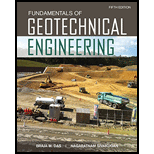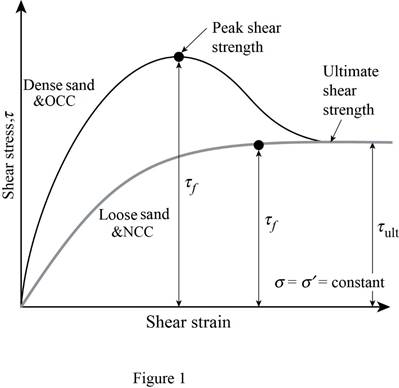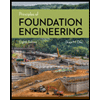
(a)
Find whether the statement “For normally consolidated clays
(a)
Answer to Problem 10.1P
The statement, “For normally consolidated clays
Explanation of Solution
According to Mohr-Coulomb failure criteria, the value of effective stress cohesion
The effective stress cohesion is approximated as 0 for normally consolidated clay.
Therefore, the statement, “For normally consolidated clays
(b)
Find whether the statement “Peak friction angle cannot be less than the ultimate friction angle” is true or false.
(b)
Answer to Problem 10.1P
The statement, “Peak friction angle cannot be less than the ultimate friction angle” is true.
Explanation of Solution
When the load is applying on a dense sand, the resisting shear stress increases with shear displacement until it attains a failure stress of
The shear stress gradually decreases with increases of shear displacement after reaches the failure stress. The continuous increase of shear displacement finally attains a constant value, then it is called ultimate shear strength.
Express the peak shear strength as follows:
Find the peak friction angle
Express the ultimate shear strength as follows:
Find the ultimate friction angle
Refer to Figure 10.6, “Determination of shear strength parameters for a dry sand using the results of direct shear stress” in the textbook.
From the Figure 10.6, the peak friction angle
The statement, “Peak friction angle cannot be less than the ultimate friction angle” is true.
(c)
Find whether the statement “The stress strain plot of a dense sand is similar in shape to that of a normally consolidated clay” is true or false.
(c)
Answer to Problem 10.1P
The statement, “The stress strain plot of a dense sand is similar in shape to that of a normally consolidated clay” is false.
Explanation of Solution
Sketch the stress-strain relationship for loose and dense sand as shown in Figure 1.

Refer to figure 1
The stress-strain curve for the loose sand is same as that of the normally consolidated clay.
The stress-strain curve for the dense sand is same as that of the over consolidated clay.
The statement, “The stress strain plot of a dense sand is similar in shape to that of a normally consolidated clay” is false.
(d)
Find whether the statement “Sensitivity of a clay can be less than one” is true or false.
(d)
Answer to Problem 10.1P
The statement, “Sensitivity of a clay can be less than one” is false.
Explanation of Solution
The sensitivity of clays is defined as the ratio of the unconfined compressive strength of clay in undisturbed to remoulded state.
The sensitivity of clay varies from 1 or
The statement, “Sensitivity of a clay can be less than one” is false.
(e)
Find whether the statement “
(e)
Answer to Problem 10.1P
The statement, “
Explanation of Solution
In consolidated undrained test, the shear strength parameters for over consolidated clay based on effective stress c and
In an unconsolidated undrained test, the failure envelope for the total stress lies on the horizontal line.
Hence,
The statement, “
Want to see more full solutions like this?
Chapter 10 Solutions
Fundamentals of Geotechnical Engineering (MindTap Course List)
- A consolidated-drained triaxial test on a sand yields the results:All-around confining pressure = σ3 = 30 lb/in2Added axial stress at failure = Δσ = 96 lb/in2Determine the shear stress parameters (i.e., Φ' and c')arrow_forwardA consolidated-drained tri-axial test was conducted on a normally consolidated clay. The results are as follows: 03 = 276 kN/m? (Aoa)f = 276 kN/m² Determine a. Angle of friction, o' b. Angle 0 that the failure plane makes with the major principal plane c. Find the normal stress o' and the shear stress tf on the failure plane d. Determine the effective normal stress on the plane of maximum shear stress of Effective stress failure envelope ↑ B of 20 276 kN/m2 A oj = 552 kN/m² Normal stress Shear stress © Cengage Learning 2014arrow_forward7.12 A sand specimen was subjected to a drained shear test using hollow cylin- der test equipment. Failure was caused by increasing the inside pressure while keeping the outside pressure constant. At failure, o, = 193 kN/m² and o; = 264 kN/m². The inside and outside radii of the specimen were 40 and 60 mm, respectively. (a) Calculate the soil friction angle. (b) Calculate the axial stress on the specimen at failure.arrow_forward
- 2. A triaxial shear test was performed on a well-drained sand sample. The normal stress on the failure plane and the shear stress on the failure plane, at failure was determined to be 6,300 psf and 4,200 psf, respectively. a. Determine the angle of internal friction of the sand. b. Determine the angle of failure plane. c. Determine the maximum principal stress.arrow_forwardA consolidated-drained tri-axial test was conducted on a normally consolidated clay. The results are as follows: O3 = 150 kN/m? (Aoa)f= 130 kN/m? Determine a. Angle of friction, o' b. Angle 0 that the failure plane makes with the major principal plane c. Find the normal stress o' and the shear stress tf on the failure plane d. Determine the effective normal stress on the plane of maximum shear stressarrow_forwardA triaxial shear test was performed on a well-drained sand sample. The normal stress on the failure plane and the shear stress on the failure plane, at failure were determined to be 6100 psf and 4600 psf, respectively. a. Determine the angle of internal friction of the sand? b. Determine the angle of the failure plane? c. Determine the maximum principal stress? Please answer this asap. For upvote. Thank you very mucharrow_forward
- 3. [Mohr's Circle] (: ). For the stressed soil element shown below, determine a. Major Principal Stress in psi. b. Minor Principal Stress in psi. c. Normal Stress at Failure Plane AE in psi. d. Shear Stress at Failure Plane AE in psi. 150 psi 60 psi D. 90 psi 60 psi 45° A Barrow_forward10-14. The state plane stress in a mass of dense cohesionless sand is described by the following stresses: Normal stress on horizontal plane Normal stress on vertical plane = 200 kPa Shear stress on horizontal and vertical planes 370 kPa 80 kPa %3! Determine by means of the Mohr circle the magnitude and direc- tion of the principal stresses. Is this state of stress safe against failure? (After A. Casagrande.)arrow_forwardA consolidated-drained triaxial test was conducted on a normally consolidated clay.The results were as follows:σ3 = 276 kN/m2(Δσd)f = 276 kN/m2a. Find the angle of friction. ϕ'.b. What is the angle that the failure plane makes with the major principal stress?c. C. Determine the normal stress σ' and the shear stress τf on the failure plane.arrow_forward
- SITUATION 5: A sand sample is subjected to direct shear testing at it's (in - situ) water content. Two tests are performed. For one of the tests, the sample shears at a stress of 400 kPa when the normal stress is 600 kPa. From these data, 15. Determine the value of the apparent cohesion. c. 230 kPa d. 221 kPa а. 100 kPa b. 179 КРа 16. Determine the corresponding angle of internal friction. a. 22.65 degrees b. 26.57 degrees c. 32.54 degrees d. 18.43 degreesarrow_forwardThe shear strength of a normally consolidated clay can be given by theequation (tau)f=(sigma prime)tan(21). The results of a consolidated-undrained test on theclay areChamber confining pressure 5 225 kN/m2Deviator stress at failure 5 112 kN/m2Determine:a. The consolidated-undrained (total stress) friction angleb. Pore water pressure developed in the specimen at failurearrow_forwardA sample was obtained from point A in the submerged clay layer shown below. It was determined that it had a w = 54%, and a G, = 2.78. What is the effective vertical stress at A? ▼ water Saturated clay h₁ = 25 m h, = 15 marrow_forward
 Fundamentals of Geotechnical Engineering (MindTap...Civil EngineeringISBN:9781305635180Author:Braja M. Das, Nagaratnam SivakuganPublisher:Cengage Learning
Fundamentals of Geotechnical Engineering (MindTap...Civil EngineeringISBN:9781305635180Author:Braja M. Das, Nagaratnam SivakuganPublisher:Cengage Learning Principles of Geotechnical Engineering (MindTap C...Civil EngineeringISBN:9781305970939Author:Braja M. Das, Khaled SobhanPublisher:Cengage Learning
Principles of Geotechnical Engineering (MindTap C...Civil EngineeringISBN:9781305970939Author:Braja M. Das, Khaled SobhanPublisher:Cengage Learning Principles of Foundation Engineering (MindTap Cou...Civil EngineeringISBN:9781305081550Author:Braja M. DasPublisher:Cengage Learning
Principles of Foundation Engineering (MindTap Cou...Civil EngineeringISBN:9781305081550Author:Braja M. DasPublisher:Cengage Learning


